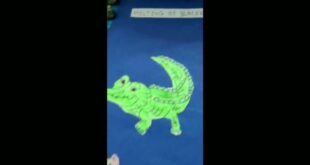Erosion of the ozone layer 360 million years ago was responsible for a mass extinction
A mass extinction 360 million years ago that killed off many of the Earth’s plants and freshwater animals was caused by a breakdown of the ozone layer.
Scientists from the University of Southampton found evidence that it was high levels of ultraviolet radiation that destroyed the ancient forest ecosystem.
This newly discovered extinction mechanism was caused by changes in the Earth’s temperatures and climate cycle – this led to the deadly ozone breakdown.
Study authors warn that we could face a similar scenario as we head towards similar global temperatures that existed 359 million years ago due to climate change.
Lead researcher Professor John Marshall said the ozone shield – that protects the Earth from harmful UV radiation – vanished for a short period of time.
He said when it vanished it coincided with a brief and quick warming of the Earth.
‘Our ozone layer is naturally in a state of flux – constantly being created and lost – and we have shown this happened in the past too, without a catalyst such as a continental scale volcanic eruption.’
The scientists found evidence that high levels of UV radiation destroyed forest ecosystems and killed many species of fish and tetrapods.
This was at the end of the Devonian geological period, 359 million years ago.
Other types of mass extinctions include an asteroid hitting the Earth 66 million years ago causing dinosaur extinction and a huge scale continental volcanic eruption that destabilised the Earth’s atmosphere and ocean 252 million years ago.
The team discovered that this damaging burst of UV radiation occurred as part of one of the Earth’s climate cycles, rather than by a huge volcanic eruption.
They found that the ozone collapse occurred as the climate rapidly warmed following an intense ice age.
Study authors warned that the Earth could reach similar temperatures, triggering a possible extinction event on the same scale – if something isn’t done to slow the pace of climate change.
The team collected rock samples from mountainous polar-regions in East Greenland, the lake was situated in the Earth’s southern hemisphere 350 million years ago.
At the time the lake would have been similar in nature to modern day Lake Chad on the edge of the Sahara Desert.
Other rocks were collected from the Andean Mountains above Lake Titicaca in Bolivia – these South American samples were from the southern continent of Gondwana, which was closer to the Devonian South Pole.
They dissolved the rocks in hydrofluoric acid, releasing microscopic plant spores, like pollen, but from fern-like plants that didn’t have seeds or flowers.
These spores have lain preserved in rocks for hundreds of millions of years.
The scientists found many of the spores had bizarrely formed spines on their surface – a response to UV radiation damaging their DNA.
Many spores had dark pigmented walls believed to be a ‘protective tan’ due to increased and damaging UV levels.
The scientists concluded that, during a time of rapid global warming, the ozone layer collapsed for a short period, exposing life on Earth to harmful levels of UV radiation.
This then trigged a mass extinction event on land and in shallow water at the Devonian-Carboniferous boundary.
The ice sheets melted and the climate became very warm – resulting in naturally generated ozone destroying chemicals in the upper atmosphere.
This let in high levels of UV-B radiation for several thousand years – killing some plants and fish, the team wrote.
During the extinction, plants selectively survived, but were enormously disrupted as the forest ecosystem collapsed.
The dominant group of armoured fish became extinct. Those that survived – sharks and bony fish – remain to this day the dominant fish in our ecosystems.
These extinctions came at a key time for the evolution of our own ancestors, the tetrapods – four legged vertebrates. These early tetrapods are fish that evolved to have limbs rather than fins, but still mostly lived in water.
Their limbs possessed many fingers and toes at the time of the extinction.
The extinction reset the direction of their evolution with the post-extinction survivors being terrestrial and with the number of fingers and toes reduced to five.
Professor Marshall said: ‘Current estimates suggest we will reach similar global temperatures to those of 360 million years ago, with the possibility that a similar collapse of the ozone layer could occur again.’
He said if this happens it would result in ‘exposing surface and shallow sea life to deadly radiation.’
‘This would move us from the current state of climate change, to a climate emergency.’
The findings are published in Science Advances.
Original – https://www.dailymail.co.uk/sciencetech/article-8361903/Erosion-ozone-layer-360-million-years-ago-responsible-mass-extinction.html
This video was first published onSource link . We are just re-posting and re-sharing.
Y Not Freakin’ Recyclable Home
climate emergency
 Pollution Climate Change Holocene Deforestation Population Acidification Y Not Freakin' Recyclable
Pollution Climate Change Holocene Deforestation Population Acidification Y Not Freakin' Recyclable



